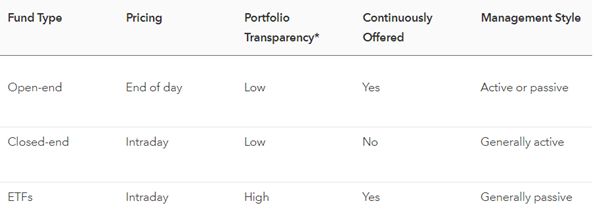Open-Ended Mutual Fund
The most common type of mutual funds, including those offered by American Funds, are known as open-end funds (while our funds are actively managed, open-end funds also include passive index funds). Open-end mutual funds typically do not limit the number of shares they can offer, and are bought and sold on demand. When an investor purchases shares in an open-end fund, the fund issues those shares and when someone sells shares, they are bought back by the fund. When shares are sold (known as a redemption), the fund pays the investor using cash on hand or it may have to sell some of its investments in order to pay the investor.
Open-end mutual funds are also priced differently from closed-end mutual funds, which trade on a market similar to a stock. Shares of open-end funds are bought and sold directly from the fund at a price per share that is based on the value of the fund’s underlying securities. On each trading day, typically at the end of the day, the net asset value (NAV) is calculated by dividing the market value of the fund’s assets (less expenses) by the number of shares held by investors.
Advantages of Open-Ended Funds
Liquidity: Open-ended funds offer high liquidity due to which you can redeem your units at your convenience. When compared to other types of long-term investments, open-ended funds provide the flexibility for redemption at the prevailing Net Asset Value (NAV).
Availability of Track Record: In case of a closed-ended fund, you cannot review the performance of the fund over different market cycles on account of non-availability of track record. However, in the case of open-ended funds, the historical performance of the fund is available. Hence, investing in an open-ended fund is a well-informed decision.
Systematic Investment Form: Closed-ended funds require investors to invest a lump sum to buy the units of the fund at the time of their launch. This can be a risky approach to deal with your investments. It exposes you to take bigger bets than otherwise warranted. However, open-ended funds are a suitable investment option for a large number of salaried classes of investors. It is because they can invest via systematic investment plans (SIP).
Disadvantages of Open-Ended Funds
Suffers from Market Risk: Even though the fund manager of open-ended funds maintains a highly diversified portfolio, they are subject to market The NAV of the fund keeps fluctuating according to the movements of the underlying benchmark.
No Say in Asset Composition: Open-ended funds appoint fund managers who are well-qualified and have experience in the field of fund management. They take all the decisions related to the selection of securities for the fund. Hence, the investors do not have a say in deciding the asset composition of the fund.
Closed-Ended Mutual Funds
Since closed-end mutual funds are traded among investors on an exchange, they have a fixed number of shares. Like stocks, closed-end funds are launched through an initial public offering (IPO) in order to raise money before they can trade in the open market. Although their value is also based on the fund’s NAV, the actual price of the fund is determined by supply and demand, so it can trade at prices above or below the value of its holdings. Closed-end funds are often actively managed unlike exchange-traded funds, which track an index and generally do not trade at a discount or premium to their NAV.
Advantages of Closed-Ended Funds
Stable Asset Base: In closed-ended funds, the investors can redeem their units only on predefined dates, i.e. when the fund matures. This allows portfolio managers to get a stable base of assets, which is not subject to frequent redemptions. A stable asset base allows the fund manager to formulate an investment strategy more comfortably. The fund managers can also keep the fund objectives holistically in mind without having to worry about the inflows and outflows in the case of stable asset bases.
Availability of Market Prices: Closed-ended funds primarily trade on stock exchanges like equity shares. This provides an opportunity for investors to buy/sell fund units based on real-time prices, which can be above (premium) or below (discount) the fund’s NAV. They can also make use of the usual stock trading strategies like market/limit orders and margin trading.
Liquidity and Flexibility: Investors are allowed to liquidate closed-ended funds as per the fund norms. Investors can utilise real-time prices available during the trading day to buy/sell closed-ended fund units at the prevailing market prices. This provides the necessary flexibility to decide on their investments by using real-time information.
Disadvantages of Closed-Ended Funds
Poor Performance- Performance of the closed-ended schemes has not been on par with open-ended peers across different time horizons. The lock-in period on closed-ended funds are aimed at giving the fund managers the flexibility to allocate the funds without the fear of outflows has not helped much in generating better returns.
Lump Sum Investment- Closed-ended funds require you to invest a lump sum at the time of their launch. This can be a risky approach to deal with your investments. It exposes you to take bigger bets than otherwise warranted. Moreover, a large number of salaried classes of investors are unable to afford lump sum investments. They, instead, prefer staggered investments by way of systematic investment plans (SIP).
Non-Availability of Track Record- In case of open-ended funds, investors can review the performance of the funds over different market cycles on account of availability of historical data. However, in the case of closed-ended funds, the track record is not available. Hence, investing in a closed-ended fund attracts uncertainties for which you can only depend on the fund manager.
Closed-End vs. Open-End Funds
Both types of mutual funds have been around for quite a while. Closed-end funds are the oldest, having been introduced in the late 19th century; open-end funds followed in the early 20th century. American Funds’ oldest offering, The Investment Company of America: registered: (ICA), was established in 1926 as an investment trust, which is similar to a closed-end fund. In 1933, ICA became a publicly owned closed-end fund and began operations under management by Capital Group a year later. By the end of the decade, ICA became an open-end mutual fund.
Today, open-end funds are by far the most popular among individual investors, who often have exposure to them through a 401(k) or other company-sponsored retirement plan. An open-end fund allows investors to participate in the markets and have a great deal of flexibility regarding how and when they purchase shares. Closed-end mutual funds may be more volatile; investors usually need to buy or sell them through a broker and are bound by the market price. But don’t confuse a closed-end fund with a “closed fund,” which is an open-end fund that no longer accepts new investors.








